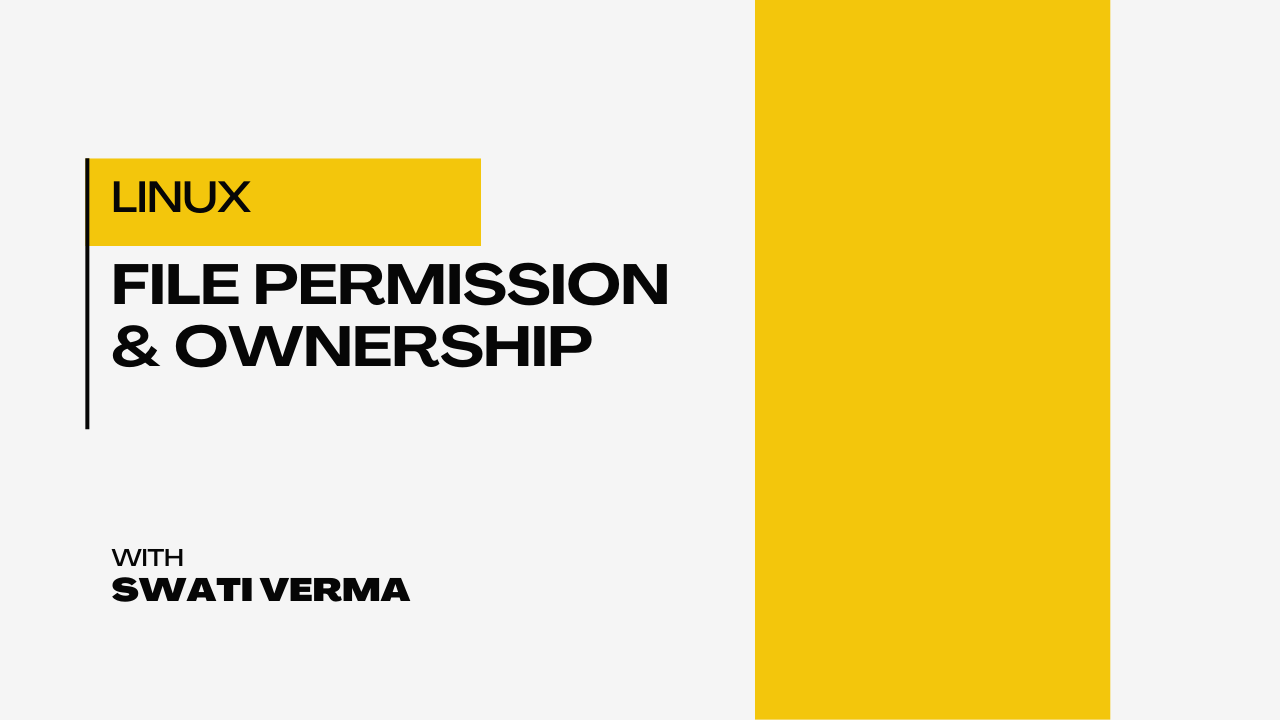File Permissions & Ownership
 Swati Verma
Swati Verma
File permissions and ownership are crucial for system security. The commands chmod, chown, and chgrp are used to manage these aspects.
chmod (change mode)
Purpose: It is used to change the permissions of a file or directory. These permissions determine who can read, write, or execute the file.
Permissions:
Permissions are divided into three categories:
User (u): The owner of the file.
Group (g): Members of the group that owns the file.
Others (o): Everyone else.
Each category can have three types of permissions:
Read (r): Allows viewing the file's contents or listing a directory's contents.
Write (w): Allows modifying the file or adding/removing files in a directory.
Execute (x): Allows running the file as a program or entering a directory.
Notation:
chmod can use two types of notation:
Numeric Mode: You can use a numeric mode to set permissions. Each permission (read, write, execute) is assigned a value: read (4), write (2), and execute (1).
Symbolic Mode: You can use symbolic notations to change permissions. The symbolic mode includes:
- "+" to add permissions
- "-" to remove permissions
- "=" to set permissions explicitly
- "r" for read, "w" for write, and "x" for execute
- "u" for the owner, "g" for the group, and "o" for others, and "a" for all (owner, group, and others)
Commands
To list the permissions : ls -l

How to change permissions?
Symbolic Examples:
chmod u+r <file_name> // For adding permission chmod ugo+r <file_name> chmod a+rwx <file_name> // (Adding permission for all) chmod ugo-r <file_name> // For removing permission
Numeric Examples:
sudo chmod 600 <file-name> // very restrictive, and used for very sensitive files.
sudo chmod 777 <file-name> // grants full permissions to everyone.


Note : A user cant change permissions of other users
Changing Permissions Recursively: To change permissions recursively for a directory and its contents, you can use the -R option with chmod.
chmod -R 755 directory_name
chown (change owner)
Purpose: chown is used to change the ownership of a file or directory. This means changing the user and/or group that owns the file.
Usage: You can change both the user and group ownership at the same time, or just one of them.
Example 1 :
sudo chown sumati playingXI
Output

Changes the owner to "sumati".
Example 2:
chown sumati:friends bowlers
Output

Changes the owner to "sumati" and the group to "friends".
chgrp (change group)
Purpose: chgrp is used to change the group ownership of a file or directory.
Usage: It specifically targets the group association of a file.
Example:
sudo chgrp rishita bowlers
Output:

Changes the group ownership to "group1".
Relationship to chown: While chown can also change the group, chgrp provides a dedicated command for this specific task.
Access Control List - ACL
What is ACL?
ACLs are a set of permissions that can be applied to files and directories, allowing for more fine-grained control over who can access and manipulate these resources.
It allows you to give more specific set of permissions to a file or directory without changing the base ownership and permissions.
Commands - setfacl & getfacl
Viewing ACLs: You can use the getfacl command to display the ACL for a file or directory
To modify ACLs, you can use the setfacl command.
- For adding permission for user
setfacl -m u:username:permissions /path/to/file
The -m option tells setfacl to modify the ACL of the file
Here + sign indicates that ACL is used.
For adding permission for group
setfacl -m g:group:rwx <target_file>To change the Primary Group Permission
setfacl -m g::rwx <file-name>
To remove a specific entry
setfacl -x u:user:rwx <target_file>
The -x option tells setfacl to remove the ACL entry for the user
setfacl -x g:swati_verma batters
- To remove all entries : setfacl -b <target_file>
- For adding permission for user in all the files inside a folder
setfacl -Rm "entry" <target_file/folder>
setfacl -Rm u:swati_verma:rw practice/
Use Case: ACL vs. chmod in a Real-World Scenario
Scenario:
Imagine you are working on a project directory (/project) that multiple users need access to, but with different levels of permissions.
The owner (you) should have full access (rwx).
The developer group should have read and write access (rw-).
A tester user (tester1) should have read-only access (r--).
Using chmod alone, you cannot grant different permissions to individual users; you can only set permissions for owner, group, and others. ACL solves this by allowing finer control.
Solution 1: Using chmod (Limited Control)
mkdir /project
chown swati:developers /project # Set owner to 'swati' and group to 'developers'
chmod 770 /project # Owner and group get full access, others get no access
Issue:
This works for the developers group, but tester1 (who is not in the developers group) cannot access the directory.
You cannot assign different permissions to individual users without changing the group structure.
Solution 2: Using ACL (Fine-Grained Control)
Step 1: Set basic permissions
chmod 770 /project # Owner and group have full access, others have no access
Step 2: Give read-only access to tester1 using ACL
setfacl -m u:tester1:r /project # Give tester1 read-only access
Step 3: Verify ACL settings : getfacl /project
Output:
# file: /project
# owner: swati
# group: developers
user::rwx
user:tester1:r-- # Custom ACL entry
group::rwx
mask::rwx
other::---
Result:
Owner (swati) → Full access (rwx)
Developers group → Full access (rwx)
Tester1 → Read-only (r--)
✅ ACL allows you to give individual users permissions without modifying group settings.
Subscribe to my newsletter
Read articles from Swati Verma directly inside your inbox. Subscribe to the newsletter, and don't miss out.
Written by

Swati Verma
Swati Verma
Growing in DevOps, together! 🤝 | Associate Software Engineer at Tech Mahindra | Enthusiastic about automation, cloud solutions, and efficient software delivery. | Let's connect, collaborate, and learn from each other!